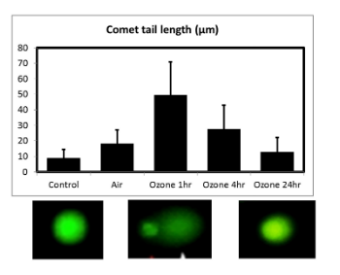Our work is open to undergraduates at Chaminade University and we frequently host Hawaii State Science Fair students. Chaminade students have worked on many different projects and generally present their findings at ABRCMS, SACNAS, and other society meetings. Chaminade students should contact Dr. Dohm for opportunities to contribute.
Air pollution and gene expression
My current research interests involve use of cell lines to investigate how air pollution mixtures influence gene expression. We are interested in how air pollutant gasses and particulates may contribute to development of chronic lung diseases. Our work is primarily with cell lines and involves gene expression profiling. We study the effects of ozone, a common component of urban smog as a model air pollutant, and sulfur dioxide and other components of Hawaii’s VOG on differentiation and proliferation of cells. Ozone is not a pollutant of particular concern here in Hawaii, but because the levels of ozone are typically low we can study effects without the need for elaborate efforts to reduce background levels. We use qPCR and focused pathway microarray approaches in our work and have developed a significant bioinformatics effort as well. Funding for this work has largely been due to generous support from NIH INBRE.
Air pollution and DNA damage
Our work has focused on the contributions of heavy metals collected from road-side and dust collections collected from various locations on the islands. We are using gene expression profiling of lung cells to model exposures to investigate effects of volcanic emissions on regulation of cell proliferation and other processes related to respiratory disease.

At right is a Comet assay image and bar chart (mean + SD) of the rat lung cell line L2 (ATCC CCL-149) one hour, four hours, or twenty-four hours after exposure to Air or Ozone (0.2 ppm) for 30 minutes. DNA damage is a well recognized consequence of exposure to ozone and we use this assay to select concentrations and duration of exposure when cell viability is greater than 90% and cells exhibit little DNA damage by 24 hours post exposure.
